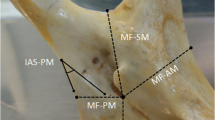Abstract
Introduction
The position of mandibular foramen is variable at the medial aspect of mandibular ramus. Nevertheless its location is useful for the oral and maxillofacial surgeon in orthognatic surgery, especially in vertical ramus osteotomy (VRO) procedure. The aim of our study is to analyse the position of mandibular foramen in order to provide simple and reliable surgical landmarks.
Materials and methods
A radio-anatomical study was undertaken on normal mandibular panoramic X-ray examinations. Precise reproductions were outlined on tracing paper. Original orthonormal landmark was designed using posterior border of the ramus, mandibular incisure and anterior border of the ramus. All these elements are visible in the patient in VRO. Measurements of the position of mandibular foramen in horizontal and vertical dimensions were then performed with a ruler by two independent observers: l (width of mandibular branch), x (distance between posterior border of the ramus and mandibular foramen), h (height of mandibular branch) and y (distance between sigmoid notch and mandibular ramus). x/l and y/h ratios were calculated in order to minimise magnifications and image distortions due to the imaging process.
Results
Forty-six panoramic X-rays were analysed, including 24 male and 22 female specimens (sex-ratio 1.1/1) with the mean-age 21 years. In vertical dimension, y/h ratio was distributed on a gaussian mode with a peak around 0.30–0.35, mandibular foramen was located around the midpoint of the inferior two-thirds and the superior third of the ramus, preferentially under this point. In horizontal dimension, x/l ratio observed the same model with a peak around 0.35; mandibular foramen was located around the midpoint of the anterior two-thirds and the posterior third of the ramus, preferentially in front of this point. Mandibular foramen was situated in the ventral and inferior two-thirds of the ramus without difference according to the side, sex or age.
Discussion
Posterior and superior thirds of the ramus constitute a “safety zone” where mandibular foramen is unlikely to be found. This area can be used by the oral and maxillofacial surgeon in vertical ramus osteotomy of the mandible with low inferior alveolar nerve morbidity probability.







Similar content being viewed by others
References
Dal Pont G (1959) Retro-molar osteotomy for correction of prognathism. Minerva Chir 14:1138–1141
Hayward J, Richardson ER, Malhotra SK (1977) The mandibular foramen: its anteroposterior position. Oral Surg Oral Med Oral Pathol 44:837–843
Jerolimov V, Kobler P, Keros J et al (1998) Assessment of position of foramen mandibulae in recent adult population. Coll Antropol 22:169–177
Kositbowornchai S, Siritapetawee M, Damrongrungruang W et al (2007) Shape of the lingula and its localization by panoramic radiograph versus dry mandibular measurement. Surg Radiol Anat 29:689–694
Nicholson ML (1985) A study of the position of the mandibular foramen in the adult human mandible. Anat Rec 212:110–112
Osaka N (1989) Studies on the position of the mandibular foramen. Shoni Shikagaku Zasshi 27:9–20
Robinson M (1957) Micrognathism corrected by vertical osteotomy of ascending ramus and iliac bone graft: a new technique. Oral Surg Oral Med Oral Pathol 10:1125–1130
Trauner R, Obwegeser H (1957) The surgical correction of mandibular prognathism and retrognatia with consideration of genioplasty. I. Surgical procedures to correct mandibular prognathism and reshaping of the chin. Oral Surg Oral Med Oral Pathol 10:677–689
Trost O, Abu El-Naaj I, Trouilloud P et al (2008) High cervical transmasseteric anteroparotid approach for open reduction and internal fixation of condylar fracture. J Oral Maxillofac Surg 66:201–204
Trost O, Kadlub N, Robe N et al (2008) Third molar surgery under general anaesthesia: a review of 180 patients. Rev Stomatol Chir Maxillofac 109:91–95
Tsai HH (2004) Panoramic radiographic findings of the mandibular foramen from deciduous to early permanent dentition. J Clin Pediatr Dent 28:215–219
Walker DG (1964) A calendar of facial growth. Br J Plast Surg 17:424–429
Author information
Authors and Affiliations
Corresponding author
Rights and permissions
About this article
Cite this article
Trost, O., Salignon, V., Cheynel, N. et al. A simple method to locate mandibular foramen: preliminary radiological study. Surg Radiol Anat 32, 927–931 (2010). https://doi.org/10.1007/s00276-010-0645-1
Received:
Accepted:
Published:
Issue Date:
DOI: https://doi.org/10.1007/s00276-010-0645-1




